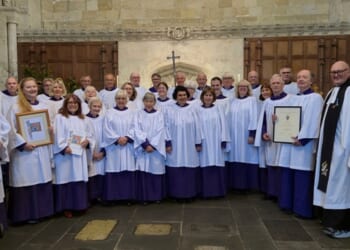(LifeSiteNews) — The suggestion by the Vatican’s doctrinal office that the titles of “Co-Redemptrix” and “Mediatrix” are not appropriate ways to describe Mary’s participation in salvation is not a slight error which might be corrected and forgotten in time. Rather, it is an unacceptable blurring of the meaning of Incarnation and of Redemption, a serious offense against the Mother of God and her son, Jesus Christ.
To understand the seriousness, one needs only to consider the basics of Catholic faith. The role of Mary in redemption has been clearly explained by theologians like Fathers Matthias Scheeben and Hans Urs von Balthasar.
The most basic element of faith is the Holy Trinity. The natural sonship of God is the source of our belief in the possibility of becoming adoptive sons and daughters of God. It is from the fact that in God there is filiation – a communication of the nature of God to His only begotten Son – that we gather the possibility of participation in the divine nature. It is God’s love for His Son and the delight He has in begetting Him that urge Him to multiply His Son’s image by creating men.
God brings into existence adoptive children in order that they also may glorify His paternity and His beloved Son. He brings this about due to a gratuitous love – a grace. Adoptive sonship is the result of the procession of the Holy Spirit, the communication of the purest love. The Holy Spirit is the pledge and seal of the communication of God with his adoptive sons. It is also the pledge and seal of the mutual love of the Father and Son inside the Trinity.
God created human life for the sole purpose of attaining eternal bliss with Him as sons. By disobeying God’s commands, and attempting to be like God – the arbiter of what is good and evil – man has made himself unfit to attain this goal. Once he became unfit to attain the goal set by God, man’s existence on earth became without purpose. Death became his destiny. But God, in His love, decided to redeem him.
Redemption means a repurchase of the lost status, at a price that would satisfy God’s justice. Redemption comes from the Latin “emptio,” meaning “purchase,” as in “caveat emptor”: buyer beware. There is a price to pay in order to be given what one wants: the renewal of grace, adoption as children, and eternal life with God.
The re-acquisition demands three conditions to meet the purchase price. The first is that the one who asks for pardon of the injustice caused to God must be innocent, undefiled, and pleasing to God. This eliminates sinful man from the task. The task is to intercede with God and be a mediator.
To be a mediator between God and man requires that he be a true man, above the rank of men, and true God. As true God, he would have to be a person distinct from the Father, and so be the Son of God. This calls for the Incarnation. The mediator is Jesus Christ, planned before creation: “In the beginning was the Word, and the Word was with God.” Saint Paul says in the first epistle to the Corinthians: “The head of every man is Christ … and the head of Christ is God.” A physical union is effected between man and God. The mediator is the person who can bring the Holy Spirit to transform men into adoptive sons by a special connection with His mystical body.
The second condition is that the action of redemption must be a work of justice and obedience in order to negate the work of injustice and disobedience. Justice is to honor God’s majesty and show one’s love for the goodness of God who called men to share His bliss. To honor God consists in totally submitting oneself to God. The value of Christs’ voluntary abasement, accepting the condition of sinful man and renouncing His rights (c.f. Philippians 2:7) as Lord of all things, was infinite. It was acceptable to God.
The third condition is that redemption should consist in voluntarily accepting suffering, in other words, a sacrifice. This is at the core of what constitutes the purchase. Sacrifice is an act of worship by which God is honored by an exchange. The buyer offers something of sufficient value for the desired object. But added to that is the requirement that a body be offered and blood spilled to seal the exchange.
In ancient times the body of an animal was burnt in exchange for the forgiveness of sins. Christ offered His own body in exchange for the pardon of the sins of all mankind. Christ, as Son of God, could have obtained the pardon by just praying for it. But by the will of the Father and by His own, the obtention of what was being asked – forgiveness and union with God – is made dependent on meritorious work.
Christ loved us to the end: the greatest proof of love is to give up one’s life for those we love. The necessity of meritorious work comes from the ordinance that, to obtain salvation, one has to be a servant of God. A willingness to suffer, to work, to combat evil, is necessary. Christ did not bring peace but a sword: a combat to the death with evil started. Redemption is not waiting for a sudden rapture: it is the result of a lifetime of struggles.
We can now compare the roles of Christ and His mother, Mary, in redemption. She is not the Redeemer, she is a helper fit for her son, as Eve was for Adam. She meets all three requirements from above: she is without sin, she is a mediator between men and her son, she magnifies the honor of her Lord who has done great things for her, and the meritorious work she performed in the Incarnation is without equal.
To obtain an estimate of Mary’s cooperation, it is necessary to keep in mind that she is a sanctuary of the Holy Spirit, which gives her a personality analogous to that of Christ. By the working of the Spirit, she became the mother of Jesus, an intimate partner in the Incarnation, which gives her a unique role in the economy of salvation. Her role in the Incarnation can be considered analogous to human marriage. Mary has been considered, from all times, to be the bride, the partner of Him that chose her to accomplish His work of salvation. Like her son, she was pure and without sin.
Redemption was the exact counterpart of the fall. As Eve, a partner fit for Adam’s task, participated subordinately in the cause of the fall, Mary participated, as the handmaid of the Lord and the antitype of Eve, in the Redemption, as a partner fit for the task. The Fathers of the Church found in that fact the proof that Mary cooperated with her son in Redemption.
From Genesis, we learn that the destruction of the works of evil are ascribed to her: she is the woman who will crush the head of the serpent. Scripture says that at the wedding in Cana, she was the instrument that caused her son’s first miracle of changing water into wine, a symbol of our necessary transformation for redemption.
At the foot of the Cross, she is given by her son to the apostle John as the mother of all who love Him as John did. At Pentecost, she is present when the Holy Spirit descends on the disciples. She not only received the Holy Spirit, but she was also the Bride of the Spirit.
In the book of Revelation, she is described as the woman with child who is attacked by the beast and takes refuge in the desert, and there the sands swallow the river of lies that tries to drown her.
From Genesis to Revelation, she is present as the handmaid of her son in the work of redemption. She does not obscure the work of grace. Grace dwells corporally in Christ and deifies Him; grace fills her, she is full of grace and distributes what she receives. She is not the sun, the Orient from on high, or the Redeemer. She is like the moon: she gently reflects the rays she receives and scatters them onto us. The moon is her symbol, as shown in the representations of Our Lady of Guadalupe.
To say that she is an obstacle to the glory of her son is an aberration. The task of the Magisterium is to teach, and what is to be taught is not hard to understand, it only needs to be done correctly. May those who published against Mary’s titles, and those who approved it, receive some of the graces she scatters, and repent of the damage they caused. They did not damage the reputation of Mary in the eyes of her sons and daughters; they damaged the reputation of the Vatican’s doctrinal office.
Bruno Jambor holds a Ph.D. in Astronomy from the University of Illinois and practiced his skills in the space industry. He is passionate about Scripture, the Traditional Latin Mass, and the ancient faith of the Fathers of the Church. He believes in passing to others the graces one receives.















